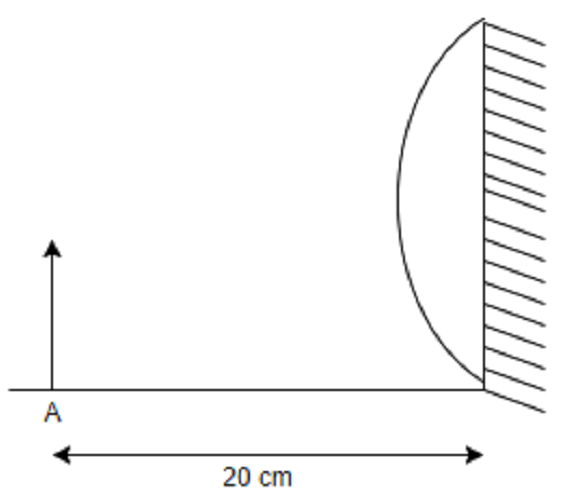
Focal length of the plano-convex lens is 15 cm. A small object is placed at \[A\] as shown in the figure. The plane surface is silvered. The image will form at?

A. 60 cm to the left of the lens
B. 12 cm to the left of the lens
C. 60 cm to the right of the lens
D. 30 cm to the left of the lens

Answer
558.9k+ views
Hint: Here we will proceed by using the concept of mirror formula. By using the mirror formula and plano-convex lens formula, we will find out the focal length.
Formula Used:
1. For the plane surface mirror, focal length formula is given by \[\dfrac{1}{v} + \dfrac{1}{u} =
\dfrac{1}{F}\]
Where, \[u\] is the distance of object
\[v\] is the distance of image
\[F\] is the focal length of the mirror.
2. For the plano-convex lens, focal length formula is given by \[\dfrac{1}{F} = \dfrac{2}{f} +
\dfrac{1}{{{f_m}}}\]
Where, \[F\] is the focal length of the mirror
\[f\] is the focal length of the plano-convex lens
\[{f_m}\] is the focal length of the plane surface
Complete step-by-step solution:
Given that a ray from point O at first gets refracted from the curved surface of focal length, \[f = 15cm\] and then reflects from the plane mirror. Hence the plano-convex lens will become a curved mirror of focal length \[F\]. So, we have
\[\dfrac{1}{F} = \dfrac{1}{{{f_m}}} - \dfrac{2}{f}{\text{ }}\left[{\because {\text{ focal length of plano convex lens is negative}}} \right]\]
Where \[{f_m}\] is the local length of mirror used which equals to infinity \[\left( \infty \right)\]
\[ \Rightarrow \dfrac{1}{F} = \dfrac{1}{\infty } - \dfrac{2}{{15}} \\ \]
\[ \Rightarrow \dfrac{1}{F} = 0 - \dfrac{2}{{15}} \\ \]
\[\therefore F = \dfrac{{ - 15}}{2}{\text{ cm}} \]
From the given figure, we have \[u = - 20\,{\text{cm}}\]
By using formula of focal length for a plane mirror i.e., \[\dfrac{1}{v} + \dfrac{1}{u} = \dfrac{1}{F}\]
We get
\[\Rightarrow\dfrac{1}{v}-\dfrac{1}{20} = -\dfrac{2}{{15}}\left[ {\because F = \dfrac{{ - 15}}{2}} \right] \\
\Rightarrow \dfrac{1}{v} = \dfrac{1}{{20}} - \dfrac{2}{{15}} \\
\Rightarrow \dfrac{1}{v} = - \dfrac{1}{{12}} \\
\therefore v = - 12{\text{ cm}} \]
The negative sign indicates that the image is 12 cm in front of the mirror.
Thus, the final image will form at 12 cm to the left of the lens. Hence, the correct option is B. 12 cm to the left of the lens.
Note: Whenever we come up with this type of question, one must know the distance between the center of a lens or curved mirror and its focus. Then we will apply the mirror formula and put the values in place of the formula. After solving that we will get our answer.
Formula Used:
1. For the plane surface mirror, focal length formula is given by \[\dfrac{1}{v} + \dfrac{1}{u} =
\dfrac{1}{F}\]
Where, \[u\] is the distance of object
\[v\] is the distance of image
\[F\] is the focal length of the mirror.
2. For the plano-convex lens, focal length formula is given by \[\dfrac{1}{F} = \dfrac{2}{f} +
\dfrac{1}{{{f_m}}}\]
Where, \[F\] is the focal length of the mirror
\[f\] is the focal length of the plano-convex lens
\[{f_m}\] is the focal length of the plane surface
Complete step-by-step solution:
Given that a ray from point O at first gets refracted from the curved surface of focal length, \[f = 15cm\] and then reflects from the plane mirror. Hence the plano-convex lens will become a curved mirror of focal length \[F\]. So, we have
\[\dfrac{1}{F} = \dfrac{1}{{{f_m}}} - \dfrac{2}{f}{\text{ }}\left[{\because {\text{ focal length of plano convex lens is negative}}} \right]\]
Where \[{f_m}\] is the local length of mirror used which equals to infinity \[\left( \infty \right)\]
\[ \Rightarrow \dfrac{1}{F} = \dfrac{1}{\infty } - \dfrac{2}{{15}} \\ \]
\[ \Rightarrow \dfrac{1}{F} = 0 - \dfrac{2}{{15}} \\ \]
\[\therefore F = \dfrac{{ - 15}}{2}{\text{ cm}} \]
From the given figure, we have \[u = - 20\,{\text{cm}}\]
By using formula of focal length for a plane mirror i.e., \[\dfrac{1}{v} + \dfrac{1}{u} = \dfrac{1}{F}\]
We get
\[\Rightarrow\dfrac{1}{v}-\dfrac{1}{20} = -\dfrac{2}{{15}}\left[ {\because F = \dfrac{{ - 15}}{2}} \right] \\
\Rightarrow \dfrac{1}{v} = \dfrac{1}{{20}} - \dfrac{2}{{15}} \\
\Rightarrow \dfrac{1}{v} = - \dfrac{1}{{12}} \\
\therefore v = - 12{\text{ cm}} \]
The negative sign indicates that the image is 12 cm in front of the mirror.
Thus, the final image will form at 12 cm to the left of the lens. Hence, the correct option is B. 12 cm to the left of the lens.
Note: Whenever we come up with this type of question, one must know the distance between the center of a lens or curved mirror and its focus. Then we will apply the mirror formula and put the values in place of the formula. After solving that we will get our answer.
Recently Updated Pages
Master Class 12 English: Engaging Questions & Answers for Success

Master Class 12 Economics: Engaging Questions & Answers for Success

Master Class 12 Social Science: Engaging Questions & Answers for Success

Master Class 12 Maths: Engaging Questions & Answers for Success

Master Class 12 Chemistry: Engaging Questions & Answers for Success

Master Class 12 Business Studies: Engaging Questions & Answers for Success

Trending doubts
What are the major means of transport Explain each class 12 social science CBSE

Which are the Top 10 Largest Countries of the World?

Draw a labelled sketch of the human eye class 12 physics CBSE

Explain sex determination in humans with line diag class 12 biology CBSE

The pH of the pancreatic juice is A 64 B 86 C 120 D class 12 biology CBSE

Explain sex determination in humans with the help of class 12 biology CBSE




